2017 KTM 250 Duke First Ride Review

Highlights
- The 2017 250 Duke is the fifth offering from KTM in India
- The KTM 250 Duke borrows the design and components from the new 390 Duke
- The KTM 250 Duke emerges as a more mature offering
Photography: Pawan Dagia
When KTM introduced the 250 Duke and RC in Japan back in 2015, little did we think then, that the motorcycle had any purpose in India. The KTM 200 Duke and 390 Duke were established products even then, but the price difference between the two wasn't expansive enough to accommodate the quarter-litre version. However, the 2017 KTM Duke range is now on sale and while the 200 Duke is now slightly cheaper, the new generation 390 has gotten more tech friendly and a lot more expensive. Naturally so, a void that was created and has now been duly filled by the 250 Duke. With India being the latest market to get the 250 cc offering, we took the 2017 250 Duke to the Bajaj test track to see what KTM's fifth offering in the country is all about.
Check out the 2017 KTM 250 Duke first ride review gallery here.
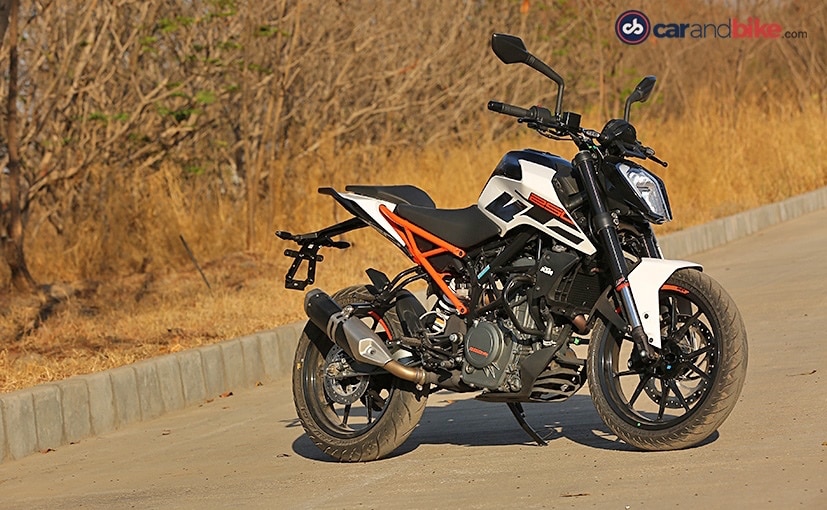
The 2017 KTM 250 Duke shares its design with the new 390 Duke
How Does It Look
The KTM 250 Duke shares its design with the new generation 390 Duke and it is one of the more stunning looking bikes in the 250 cc segment. The design language comes from the 1290 Super Duke R rubbing off a striking appearance on the mini-Duke. The sharp lines are embodied with striking graphics, while the bulbous 13.5 litre fuel tank takes centre stage and is a good 3 litre larger than that of the 200, which will appeal to the tourers with bigger travelling range now possible. Most noticeably, the 250 gets a new headlamp cluster, which unlike the 390 is a conventional unit using a halogen bulb and comes with the boomerang-shaped DRLs, which have been well-integrated into the design. The other prominent bit is the reworked trellis frame with the first half finished in black, while the new sub-frame stands out in the neon orange colour scheme. The aluminium side-mounted exhaust has been carried over on the 250, completing the styling of the bike. The new and more effective exhaust note sounds calmer and throatier than before. The ground clearance is friendlier to Indian roads at 175 mm and is the same as the 200.
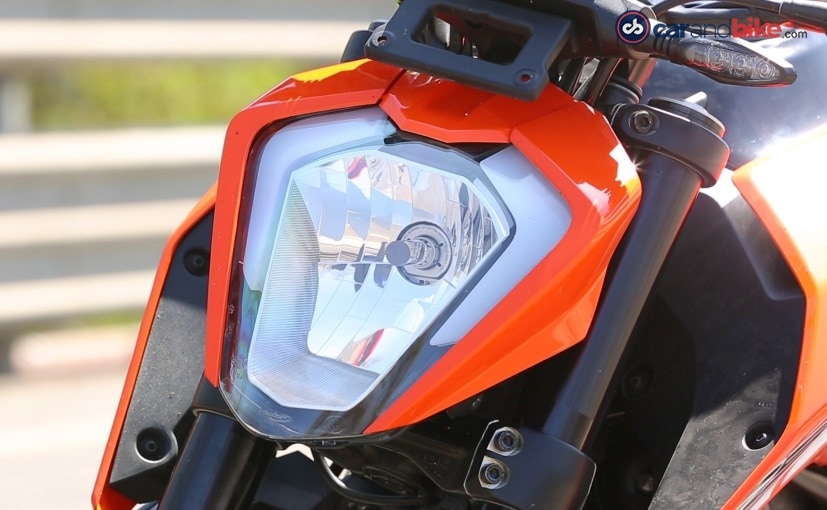
The headlamp unit gets a halogen bulb and boomerang-shaped LED DRLs
What is interesting and I really like is the new 'Duke' badging on the fuel tank just below the cap. The moniker is now seen on all Duke bikes and is more like a family crest on the 2017 range. Differentiating the 250 Duke with the 200 and bigger 390 is the black finished alloy wheels that come with contrast orange streak and are wrapped with MRF tyres. The quarter-litre motorcycle is offered in two colour options - Orange and White.
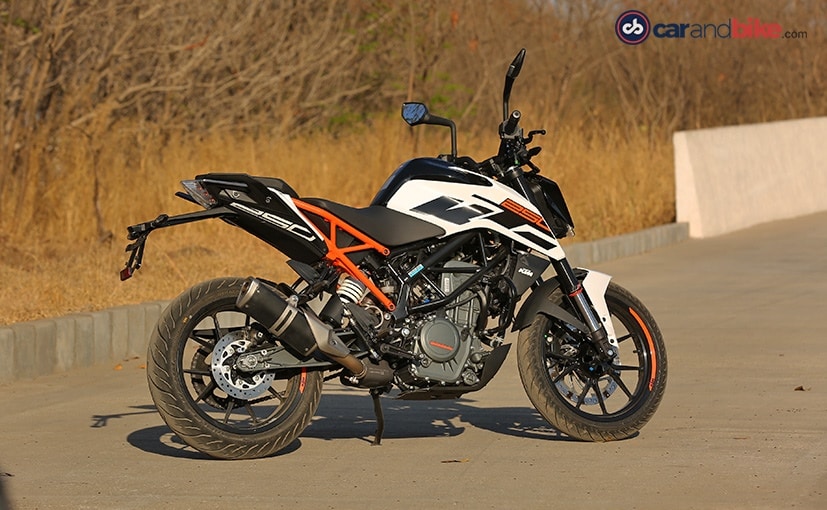
The 250 Duke borrows several components from the new 390 Duke
Features, Comfort and Switchgear
The KTM 250 Duke gets a more contoured seat for the rider and pillion and you will appreciate just how much the seat is accommodating. The new fuel tank design too quite ably makes way for additional legroom. The wide seat also allows room for adjustment on the fly. The footrest is slightly rear set than the 200 Duke, which gives it an aggressive riding position. The handlebar seems to have gone slightly wider on the 250. You sit a little taller on the quarter-litre Duke with a seat height of 818 mm, which is more than the 200 Duke, but shorter than the new 390.
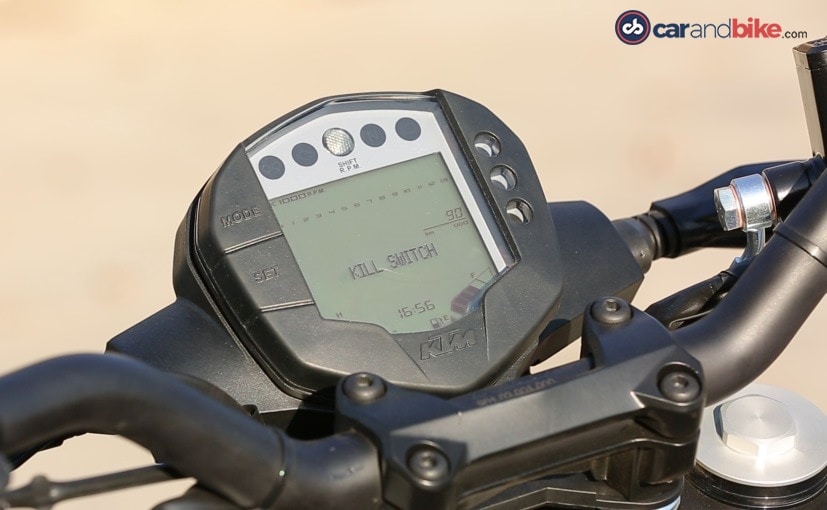
2017 KTM 250 Duke Instrument Cluster
A majority of components come from the larger 390, but certain bits like the clutch and brake levers as well as tyres are shared with the 200 Duke to keep costs in check. The touch and feel of the switchgear is the same and does the job well. Unlike the new 390 Duke, KTM has not updated for the 250 Duke with the TFT screen, for cost reasons of course. Instead, you get the same orange backlit all-digital instrumentation as the outgoing 390 and the current 200. Nevertheless, the unit now shows real time fuel consumption and a 'Kill Switch' warning sign, when the kill switch is on. Previously, the screen would just go blank and that continues to happen on the 200 Duke. Other features remain the same and you continue to get a multitude of information at all times on screen.
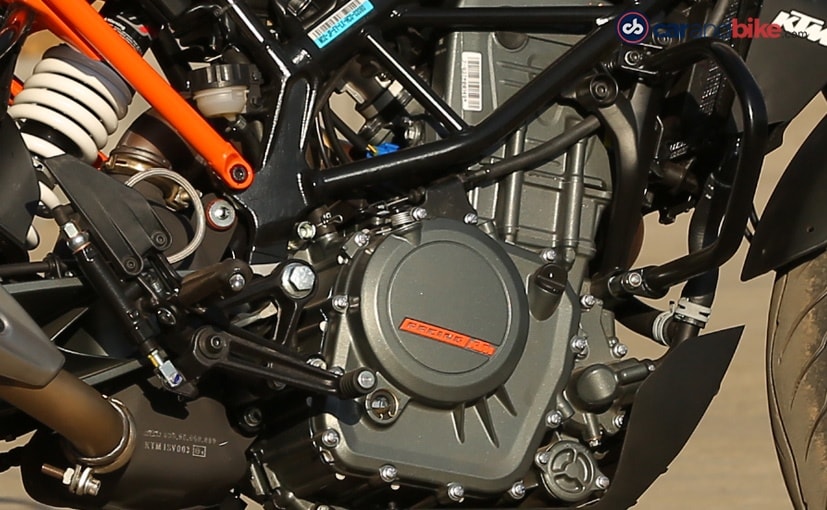
The 250 cc engine makes 29.6 bhp and 24 Nm of torque
Engine and Performance
The KTM 250 Duke may have been around in global markets since 2015, but India gets it as an all-new model. It's made at the Bajaj plant in Chakan for the world and the bike is, in a way, a downsized version of the 390 Duke, quite literally as far as the engine is concerned. The BS IV compliant 248.8 cc engine is derived from the 390's 373.2 cc unit and is a liquid-cooled, single-cylinder motor. The engine churns out 29.6 bhp of power at 9000 rpm, around 1 bhp less than the international version and 24 Nm of torque at 7500 rpm. With a kerb weight of 161 kg, the 250 boasts of a highly appreciable power-to-weight ratio of 193 bhp/tonne, which is one of the most powerful in the 250 cc space and that translates on tarmac as well. The engine is a free revving unit like all KTMs are and likes to be redlined. It is a more refined unit than you've seen on older Dukes. KTM tells us that the radiator unit from the 390 also makes it to the 250 Duke, and for the most part of our ride the engine did not show any heating issues, a problem otherwise common with the 390. That said, we would be able to make a fair assessment about this once we take the bike on actual roads and subject it to stop-go situations in traffic.
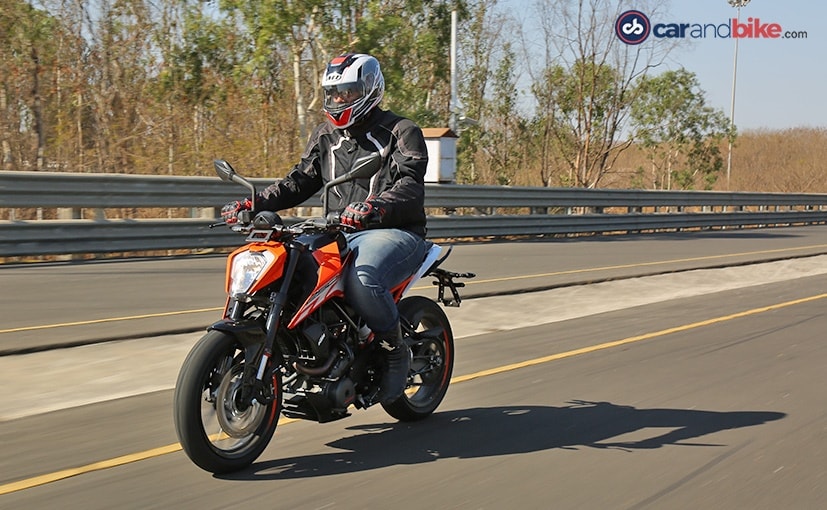
The KTM 250 Duke is powerful but not intimidating
The KTM 250 Duke is also a more likeable bike, given that it isn't as intimidating as its older sibling. So, in a way, the power output isn't a revelation in case you were thinking that way. The redline kicks in just over 10,000 rpm and speeds build up quickly without any drama. There is ample power and torque available and evens out across the range. In true KTM fashion, there is no dearth of power when you need it the most. The six-speed transmission is the same as other KTMs and is precise to the T. You can stutter between 45-60 kmph in sixth gear in comfort. Unlike the 390, the 250 Duke is less resistive that way and more forgiving as well. Also helping it in the matter is the addition of the Power Assist Slipper Clutch (PASC) that ensures downshifts happen seamlessly, without causing the rear wheel to lock at high speeds. We saw it on the 2017 RC 390 last month and are happy that KTM has extended it on the 250 now.

The 250 Duke gets the new open cartridge USD forks
Handling And Braking
Despite, the revision, the chassis on the new 250 Duke functions in the same manner as that on the older Duke range. The geometry is the same and that ensures the bike's dynamics remain sharp. The new sub-frame, however, does make it more easy to replace and repair, should the need be. The 250 Duke also benefits from the more sophisticated open cartridge USD front forks and monoshock suspension setup that have been introduced on the 2017 390 Duke. The WP sourced units have helped make the ride quality more supple than before and are able of taking undulations with ease. The ride quality is far better than the older Dukes coupled with the soft cushioning. The bike also feels more controlled than the older KTMs and in a way, feels to have matured. The fork seals on the 250 Duke are also of better quality, which again is a welcome change.
The 250 naked is a KTM after all and remains at its agile best around corners. The leaning angle remains the same as other Dukes, but you won't be scraping the underbelly given the higher ground clearance. It's extremely maneuverable and moves to the direction you point at. We are certain that it will be a breeze to ride around in traffic conditions.
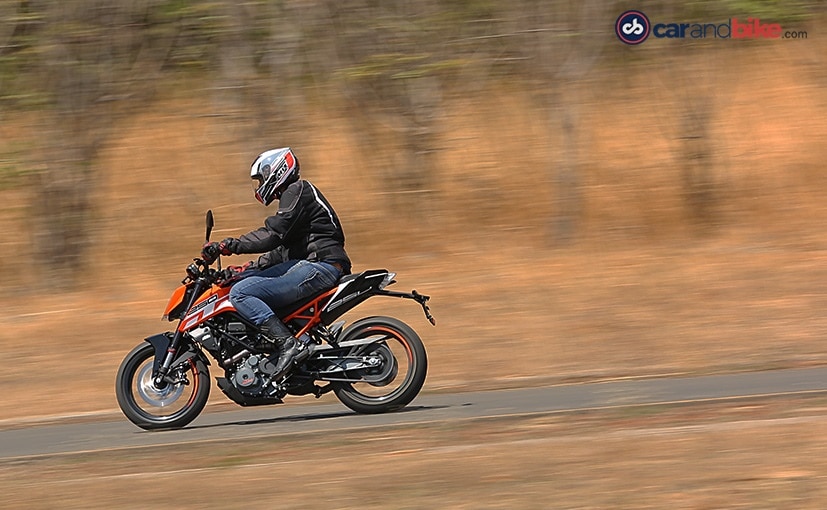
ABS is missing on the 250 Duke, even as an option
As much as I like the KTM 250 Duke, the brakes could've been much better. The bike uses a 300 mm front disc and 230 mm rear disc setup, same as the 200 Duke, but lacks feedback on the 250. Obviously, the quarter-litre Duke is heavier and more powerful as well, and the front brake lacks the bite that you want from a nearly 30 bhp machine. It's not like you won't stop, but the experience isn't most appealing. This is why the 320 mm front discs from the 390 Duke and RC should've made it to the 250 as well. More so, since the 250 Duke also misses out on ABS, even as an option.
Lastly, the KTM 250 Duke rides on MRF RevZ tyres, instead of the mighty Metzelers. The rubber does a good job and the MRFs complement the power well and offer adequate traction at all times. It's only when you want to push the throttle really hard that the rear wheel gets a little unsettling. While they may not be as pliant as the Metzelers, the tyres aren't really a bad tradeoff given the durability and price advantage that you get.

The 250 Duke is just Rs. 30,000 more expensive than the 200 Duke
Verdict -
As I told you at the start of the review, bringing the 250 would've not made much business sense to KTM India in 2015. But, the 2017 KTM Duke range is very different. The 390 is moved higher on the price scale, while the 200 really makes a case for being the entry-level model. With a gap of nearly 82,000 between the two, the KTM 250 Duke finds its sweet spot here at Rs. 1.73 lakh (ex-showroom, Delhi). The 2017 KTM 250 Duke, then, is all about balance. If the 200 Duke is noble and the new 390 Duke a little outlandish, the 250 Duke fits well into the line-up. It's just Rs. 30,000 more expensive than the 200 and a good Rs. 50,000 cheaper than the new 390. With a high-value quotient, the 250 Duke turns out to be just the right product for a mature KTM buyer, a quality this bike asserts in a big way.
Last Updated on March 3, 2017
Latest Reviews
Research More on KTM 250 Duke
Popular KTM Models
 KTM RC 200Ex-Showroom Price₹ 2.13 - 2.15 Lakh
KTM RC 200Ex-Showroom Price₹ 2.13 - 2.15 Lakh KTM 250 DukeEx-Showroom Price₹ 2.39 - 2.41 Lakh
KTM 250 DukeEx-Showroom Price₹ 2.39 - 2.41 Lakh KTM 200 DukeEx-Showroom Price₹ 1.96 - 2.03 Lakh
KTM 200 DukeEx-Showroom Price₹ 1.96 - 2.03 Lakh KTM 390 DukeEx-Showroom Price₹ 2.95 Lakh
KTM 390 DukeEx-Showroom Price₹ 2.95 Lakh KTM RC 390Ex-Showroom Price₹ 3.16 - 3.16 Lakh
KTM RC 390Ex-Showroom Price₹ 3.16 - 3.16 Lakh KTM RC 125Ex-Showroom Price₹ 1.81 - 1.86 Lakh
KTM RC 125Ex-Showroom Price₹ 1.81 - 1.86 Lakh KTM 125 DukeEx-Showroom Price₹ 1.76 Lakh
KTM 125 DukeEx-Showroom Price₹ 1.76 Lakh KTM 250 AdventureEx-Showroom Price₹ 2.42 - 2.47 Lakh
KTM 250 AdventureEx-Showroom Price₹ 2.42 - 2.47 Lakh KTM 390 AdventureEx-Showroom Price₹ 2.81 - 3.61 Lakh
KTM 390 AdventureEx-Showroom Price₹ 2.81 - 3.61 Lakh KTM 890 DukeEx-Showroom Price₹ 14.5 Lakh
KTM 890 DukeEx-Showroom Price₹ 14.5 Lakh KTM 390 Adventure X 2025Ex-Showroom Price₹ 2.91 Lakh
KTM 390 Adventure X 2025Ex-Showroom Price₹ 2.91 Lakh KTM 890 AdventureEx-Showroom Price₹ 15.8 Lakh
KTM 890 AdventureEx-Showroom Price₹ 15.8 Lakh KTM 85 SXEx-Showroom Price₹ 6.69 Lakh
KTM 85 SXEx-Showroom Price₹ 6.69 Lakh KTM 65 SXEx-Showroom Price₹ 5.47 Lakh
KTM 65 SXEx-Showroom Price₹ 5.47 Lakh KTM 50 SXEx-Showroom Price₹ 4.75 Lakh
KTM 50 SXEx-Showroom Price₹ 4.75 Lakh KTM 450 SX-FEx-Showroom Price₹ 10.25 Lakh
KTM 450 SX-FEx-Showroom Price₹ 10.25 Lakh KTM 390 Adventure 2025Ex-Showroom Price₹ 3.68 Lakh
KTM 390 Adventure 2025Ex-Showroom Price₹ 3.68 Lakh KTM 350 EXC-F SIX DAYSEx-Showroom Price₹ 12.96 Lakh
KTM 350 EXC-F SIX DAYSEx-Showroom Price₹ 12.96 Lakh KTM 250 SX-FEx-Showroom Price₹ 9.58 Lakh
KTM 250 SX-FEx-Showroom Price₹ 9.58 Lakh KTM 250 Adventure 2025Ex-Showroom Price₹ 2.6 Lakh
KTM 250 Adventure 2025Ex-Showroom Price₹ 2.6 Lakh KTM 1390 Super DukeEx-Showroom Price₹ 22.96 Lakh
KTM 1390 Super DukeEx-Showroom Price₹ 22.96 Lakh KTM 1290 Super AdventureEx-Showroom Price₹ 22.74 Lakh
KTM 1290 Super AdventureEx-Showroom Price₹ 22.74 Lakh













